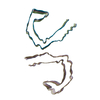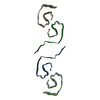+ データを開く
データを開く
- 基本情報
基本情報
| 登録情報 | データベース: PDB / ID: 8sej | ||||||
|---|---|---|---|---|---|---|---|
| タイトル | Type I beta-amyloid 42 Filaments from Down syndrome | ||||||
 要素 要素 | Amyloid-beta protein 42 アミロイドβ アミロイドβ | ||||||
 キーワード キーワード |  NEUROPEPTIDE / Beta Amyloid filaments / NEUROPEPTIDE / Beta Amyloid filaments /  Down Syndrome (ダウン症候群) / Human Trisomy 21 Down Syndrome (ダウン症候群) / Human Trisomy 21 | ||||||
| 機能・相同性 |  機能・相同性情報 機能・相同性情報regulation of epidermal growth factor-activated receptor activity / signaling receptor activator activity / collateral sprouting in absence of injury / cytosolic mRNA polyadenylation / microglia development / regulation of synapse structure or activity / Formyl peptide receptors bind formyl peptides and many other ligands / axo-dendritic transport / synaptic assembly at neuromuscular junction / smooth endoplasmic reticulum calcium ion homeostasis ...regulation of epidermal growth factor-activated receptor activity / signaling receptor activator activity / collateral sprouting in absence of injury / cytosolic mRNA polyadenylation / microglia development / regulation of synapse structure or activity / Formyl peptide receptors bind formyl peptides and many other ligands / axo-dendritic transport / synaptic assembly at neuromuscular junction / smooth endoplasmic reticulum calcium ion homeostasis / axon midline choice point recognition / astrocyte activation involved in immune response / regulation of spontaneous synaptic transmission /  regulation of Wnt signaling pathway / mating behavior / regulation of Wnt signaling pathway / mating behavior /  繊毛 / Lysosome Vesicle Biogenesis / 繊毛 / Lysosome Vesicle Biogenesis /  PTB domain binding / Golgi-associated vesicle / positive regulation of amyloid fibril formation / neuron remodeling / Insertion of tail-anchored proteins into the endoplasmic reticulum membrane / : / Deregulated CDK5 triggers multiple neurodegenerative pathways in Alzheimer's disease models / presynaptic active zone / nuclear envelope lumen / modulation of excitatory postsynaptic potential / suckling behavior / COPII-coated ER to Golgi transport vesicle / dendrite development / PTB domain binding / Golgi-associated vesicle / positive regulation of amyloid fibril formation / neuron remodeling / Insertion of tail-anchored proteins into the endoplasmic reticulum membrane / : / Deregulated CDK5 triggers multiple neurodegenerative pathways in Alzheimer's disease models / presynaptic active zone / nuclear envelope lumen / modulation of excitatory postsynaptic potential / suckling behavior / COPII-coated ER to Golgi transport vesicle / dendrite development /  小胞体 / 小胞体 /  regulation of NMDA receptor activity / TRAF6 mediated NF-kB activation / Advanced glycosylation endproduct receptor signaling / neuromuscular process controlling balance / regulation of presynapse assembly / The NLRP3 inflammasome / intracellular copper ion homeostasis / transition metal ion binding / regulation of multicellular organism growth / negative regulation of long-term synaptic potentiation / negative regulation of neuron differentiation / ECM proteoglycans / spindle midzone / positive regulation of T cell migration / regulation of NMDA receptor activity / TRAF6 mediated NF-kB activation / Advanced glycosylation endproduct receptor signaling / neuromuscular process controlling balance / regulation of presynapse assembly / The NLRP3 inflammasome / intracellular copper ion homeostasis / transition metal ion binding / regulation of multicellular organism growth / negative regulation of long-term synaptic potentiation / negative regulation of neuron differentiation / ECM proteoglycans / spindle midzone / positive regulation of T cell migration /  Purinergic signaling in leishmaniasis infection / positive regulation of calcium-mediated signaling / forebrain development / regulation of peptidyl-tyrosine phosphorylation / positive regulation of chemokine production / Purinergic signaling in leishmaniasis infection / positive regulation of calcium-mediated signaling / forebrain development / regulation of peptidyl-tyrosine phosphorylation / positive regulation of chemokine production /  クラスリン / クラスリン /  Notchシグナリング / positive regulation of G2/M transition of mitotic cell cycle / ionotropic glutamate receptor signaling pathway / positive regulation of protein metabolic process / neuron projection maintenance / cholesterol metabolic process / extracellular matrix organization / positive regulation of glycolytic process / positive regulation of mitotic cell cycle / response to interleukin-1 / Notchシグナリング / positive regulation of G2/M transition of mitotic cell cycle / ionotropic glutamate receptor signaling pathway / positive regulation of protein metabolic process / neuron projection maintenance / cholesterol metabolic process / extracellular matrix organization / positive regulation of glycolytic process / positive regulation of mitotic cell cycle / response to interleukin-1 /  軸索誘導 / adult locomotory behavior / trans-Golgi network membrane / dendritic shaft / locomotory behavior / platelet alpha granule lumen / positive regulation of peptidyl-threonine phosphorylation / 軸索誘導 / adult locomotory behavior / trans-Golgi network membrane / dendritic shaft / locomotory behavior / platelet alpha granule lumen / positive regulation of peptidyl-threonine phosphorylation /  学習 / 学習 /  central nervous system development / positive regulation of interleukin-1 beta production / positive regulation of long-term synaptic potentiation / astrocyte activation / endosome lumen / synapse organization / central nervous system development / positive regulation of interleukin-1 beta production / positive regulation of long-term synaptic potentiation / astrocyte activation / endosome lumen / synapse organization /  Post-translational protein phosphorylation / regulation of long-term neuronal synaptic plasticity / positive regulation of JNK cascade / microglial cell activation / TAK1-dependent IKK and NF-kappa-B activation / Post-translational protein phosphorylation / regulation of long-term neuronal synaptic plasticity / positive regulation of JNK cascade / microglial cell activation / TAK1-dependent IKK and NF-kappa-B activation /  visual learning / visual learning /  neuromuscular junction / serine-type endopeptidase inhibitor activity / recycling endosome / neuromuscular junction / serine-type endopeptidase inhibitor activity / recycling endosome /  認識 / positive regulation of inflammatory response / Golgi lumen / neuron cellular homeostasis / 認識 / positive regulation of inflammatory response / Golgi lumen / neuron cellular homeostasis /  エンドサイトーシス / positive regulation of interleukin-6 production / positive regulation of non-canonical NF-kappaB signal transduction / cellular response to amyloid-beta / Regulation of Insulin-like Growth Factor (IGF) transport and uptake by Insulin-like Growth Factor Binding Proteins (IGFBPs) / neuron projection development / positive regulation of DNA-binding transcription factor activity / G2/M transition of mitotic cell cycle / cell-cell junction / エンドサイトーシス / positive regulation of interleukin-6 production / positive regulation of non-canonical NF-kappaB signal transduction / cellular response to amyloid-beta / Regulation of Insulin-like Growth Factor (IGF) transport and uptake by Insulin-like Growth Factor Binding Proteins (IGFBPs) / neuron projection development / positive regulation of DNA-binding transcription factor activity / G2/M transition of mitotic cell cycle / cell-cell junction /  シナプス小胞 / positive regulation of tumor necrosis factor production / シナプス小胞 / positive regulation of tumor necrosis factor production /  regulation of translation regulation of translation類似検索 - 分子機能 | ||||||
| 生物種 |   Homo sapiens (ヒト) Homo sapiens (ヒト) | ||||||
| 手法 |  電子顕微鏡法 / らせん対称体再構成法 / 電子顕微鏡法 / らせん対称体再構成法 /  クライオ電子顕微鏡法 / 解像度: 3.17 Å クライオ電子顕微鏡法 / 解像度: 3.17 Å | ||||||
 データ登録者 データ登録者 | Hoq, M.R. / Bharath, S.R. / Vago, F.S. / Jiang, W. | ||||||
| 資金援助 |  米国, 1件 米国, 1件
| ||||||
 引用 引用 |  ジャーナル: Nat Struct Mol Biol / 年: 2024 ジャーナル: Nat Struct Mol Biol / 年: 2024タイトル: Cryo-EM structures of amyloid-β and tau filaments in Down syndrome. 著者: Anllely Fernandez / Md Rejaul Hoq / Grace I Hallinan / Daoyi Li / Sakshibeedu R Bharath / Frank S Vago / Xiaoqi Zhang / Kadir A Ozcan / Kathy L Newell / Holly J Garringer / Wen Jiang / ...著者: Anllely Fernandez / Md Rejaul Hoq / Grace I Hallinan / Daoyi Li / Sakshibeedu R Bharath / Frank S Vago / Xiaoqi Zhang / Kadir A Ozcan / Kathy L Newell / Holly J Garringer / Wen Jiang / Bernardino Ghetti / Ruben Vidal /  要旨: Adult individuals with Down syndrome (DS) develop Alzheimer disease (AD). Whether there is a difference between AD in DS and AD regarding the structure of amyloid-β (Aβ) and tau filaments is ...Adult individuals with Down syndrome (DS) develop Alzheimer disease (AD). Whether there is a difference between AD in DS and AD regarding the structure of amyloid-β (Aβ) and tau filaments is unknown. Here we report the structure of Aβ and tau filaments from two DS brains. We found two Aβ filaments (types IIIa and IIIb) that differ from those previously reported in sporadic AD and two types of Aβ filaments (I and II) identical to those found in sporadic and familial AD. Tau filaments (paired helical filaments and straight filaments) were identical to those in AD, supporting the notion of a common mechanism through which amyloids trigger aggregation of tau. This knowledge is important for understanding AD in DS and assessing whether adults with DS could be included in AD clinical trials. | ||||||
| 履歴 |
|
- 構造の表示
構造の表示
| 構造ビューア | 分子:  Molmil Molmil Jmol/JSmol Jmol/JSmol |
|---|
- ダウンロードとリンク
ダウンロードとリンク
- ダウンロード
ダウンロード
| PDBx/mmCIF形式 |  8sej.cif.gz 8sej.cif.gz | 63.6 KB | 表示 |  PDBx/mmCIF形式 PDBx/mmCIF形式 |
|---|---|---|---|---|
| PDB形式 |  pdb8sej.ent.gz pdb8sej.ent.gz | 50.1 KB | 表示 |  PDB形式 PDB形式 |
| PDBx/mmJSON形式 |  8sej.json.gz 8sej.json.gz | ツリー表示 |  PDBx/mmJSON形式 PDBx/mmJSON形式 | |
| その他 |  その他のダウンロード その他のダウンロード |
-検証レポート
| アーカイブディレクトリ |  https://data.pdbj.org/pub/pdb/validation_reports/se/8sej https://data.pdbj.org/pub/pdb/validation_reports/se/8sej ftp://data.pdbj.org/pub/pdb/validation_reports/se/8sej ftp://data.pdbj.org/pub/pdb/validation_reports/se/8sej | HTTPS FTP |
|---|
-関連構造データ
| 関連構造データ |  40416MC  8sehC  8seiC  8sekC  8selC M: このデータのモデリングに利用したマップデータ C: 同じ文献を引用 ( |
|---|---|
| 類似構造データ | 類似検索 - 機能・相同性  F&H 検索 F&H 検索 |
- リンク
リンク
- 集合体
集合体
| 登録構造単位 | 
|
|---|---|
| 1 |
|
- 要素
要素
| #1: タンパク質・ペプチド |  アミロイドβ アミロイドβ分子量: 3560.128 Da / 分子数: 10 / 由来タイプ: 天然 詳細: Type I beta-amyloid 42 filaments from Down syndrome Case 2 由来: (天然)   Homo sapiens (ヒト) / 参照: UniProt: P05067 Homo sapiens (ヒト) / 参照: UniProt: P05067 |
|---|
-実験情報
-実験
| 実験 | 手法:  電子顕微鏡法 電子顕微鏡法 |
|---|---|
| EM実験 | 試料の集合状態: FILAMENT / 3次元再構成法: らせん対称体再構成法 |
- 試料調製
試料調製
| 構成要素 | 名称: Type I beta amyloid 42 / タイプ: TISSUE / Entity ID: all / 由来: NATURAL |
|---|---|
| 由来(天然) | 生物種:   Homo sapiens (ヒト) Homo sapiens (ヒト) |
| 緩衝液 | pH: 7.2 |
| 試料 | 濃度: 1 mg/ml / 包埋: NO / シャドウイング: NO / 染色 : NO / 凍結 : NO / 凍結 : YES : YES |
急速凍結 | 凍結剤: ETHANE |
- 電子顕微鏡撮影
電子顕微鏡撮影
| 実験機器 |  モデル: Titan Krios / 画像提供: FEI Company |
|---|---|
| 顕微鏡 | モデル: TFS KRIOS |
| 電子銃 | 電子線源 : :  FIELD EMISSION GUN / 加速電圧: 300 kV / 照射モード: SPOT SCAN FIELD EMISSION GUN / 加速電圧: 300 kV / 照射モード: SPOT SCAN |
| 電子レンズ | モード: BRIGHT FIELD Bright-field microscopy / 倍率(公称値): 81000 X / 最大 デフォーカス(公称値): 5000 nm / 最小 デフォーカス(公称値): 500 nm / Cs Bright-field microscopy / 倍率(公称値): 81000 X / 最大 デフォーカス(公称値): 5000 nm / 最小 デフォーカス(公称値): 500 nm / Cs : 2.7 mm / C2レンズ絞り径: 100 µm : 2.7 mm / C2レンズ絞り径: 100 µm |
| 試料ホルダ | 凍結剤: NITROGEN |
| 撮影 | 平均露光時間: 1.103 sec. / 電子線照射量: 50.46 e/Å2 / フィルム・検出器のモデル: GATAN K3 (6k x 4k) |
- 解析
解析
| EMソフトウェア | 名称: CTFFIND / カテゴリ: CTF補正 |
|---|---|
CTF補正 | タイプ: PHASE FLIPPING AND AMPLITUDE CORRECTION |
| らせん対称 | 回転角度/サブユニット: 178.24 ° / 軸方向距離/サブユニット: 2.38 Å / らせん対称軸の対称性: C1 |
3次元再構成 | 解像度: 3.17 Å / 解像度の算出法: FSC 0.143 CUT-OFF / 粒子像の数: 45575 / 対称性のタイプ: HELICAL |
 ムービー
ムービー コントローラー
コントローラー







 PDBj
PDBj














